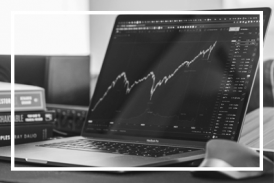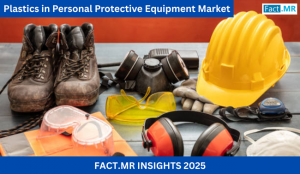Plastics in Personal Protective Equipment Market Size Worth US$ 33.67 Billion with 4.9% CAGR by 2035: Fact.MR Report
PPE Plastics Industry Adapts to Eco Shift with Smart, Lightweight, and Sustainable Innovation
ROCKVILLE, MD, UNITED STATES, June 5, 2025 /EINPresswire.com/ -- The global plastics in personal protective equipment market is projected to experience steady growth over the coming decade. Valued at approximately USD 20.84 billion in 2025, the market is expected to reach around USD 33.67 billion by 2035, expanding at a CAGR of 4.9% during the forecast period.This growth highlights the critical role plastics play in advancing personal protective equipment, driven by their key advantages such as durability, flexibility, lightweight properties, and cost-effectiveness.
As global industries place greater emphasis on occupational health and safety protocols, the demand for advanced PPE solutions made from high-performance plastics is rising across sectors such as healthcare, manufacturing, construction, and oil and gas. Key factors driving this growth include stricter workplace safety regulations and heightened awareness of occupational risk mitigation. Governments in major economies are enforcing more rigorous safety standards, compelling businesses to invest in certified PPE—much of which relies heavily on engineered plastic materials for enhanced protection, durability, and compliance.
For More Insights into the Market, Request a Sample of this Report:
https://www.factmr.com/connectus/sample?flag=S&rep_id=10741
Key Takeaways from the Market Study
Market to reach USD 33.67 billion by 2035
CAGR from 2025 to 2035 projected at 4.9%
Polyethylene (PE) leads with 24% market share in 2025
Hand protection dominates with 35% share
China expands fastest at 6.5% CAGR
U.S. poised to grow at 5.7% CAGR during the forecast period
Regional Insights
The U.S. market for plastics in personal protective equipment is projected to grow at a CAGR of 5.7% during the forecast period. Rising concerns over worker safety in sectors such as healthcare, manufacturing, and construction are significantly boosting the demand for PPE made from advanced plastic materials.
In the U.K., the plastics in personal protective equipment market is anticipated to expand at a CAGR of 5%. Growing safety concerns across industrial, healthcare, and construction sectors are driving the need for plastic-based PPE. Innovations in lightweight, high-strength, and reusable protective gear are further creating new growth opportunities.
Germany’s plastics in personal protective equipment market is expected to register a CAGR of 4.5% over the study period. As a key hub for industrial manufacturing and healthcare, Germany shows strong demand for reliable, durable, and efficient plastic-based PPE solutions.
Survey Insights and Stakeholder Priorities
Fact.MR’s survey highlights a strong shift toward sustainability, with 89% of stakeholders calling for recyclable plastics in PPE. Comfort and ergonomic performance ranked high, influencing material selection across industries. Regional preferences vary—North America favors chemical resistance, Europe emphasizes sustainability, and Asia-Pacific focuses on scalability and cost. Smart PPE adoption is rising, with 67% exploring sensor integration and antimicrobial treatments. Supply chain concerns persist, particularly around raw material pricing volatility. Future investment themes include medical PPE automation, green polymer innovation, and regional manufacturing resilience.
Companies Targeting
Leading players like BASF SE, SABIC, and Evonik Industries are setting the pace with specialized plastic portfolios and integrated production systems. BASF's Ultramid and Elastollan brands are used in face shields and garments, while SABIC's polycarbonates are essential for impact-resistant PPE. Evonik’s lightweight and chemical-resistant solutions cater to healthcare and industrial safety. Arkema and Sumitomo are pushing sustainable materials into the spotlight with bio-based offerings that meet both regulatory and user demands. Competitive positioning revolves around material performance, ESG compliance, and regional production agility.
Get Customization on this Report for Specific Research Solutions:
https://www.factmr.com/connectus/sample?flag=S&rep_id=10741
Segmental Insights
Polyethylene (PE) dominates due to its use in high-volume disposable PPE such as gowns and aprons. Its affordability and flexibility make it ideal for the medical and food sectors. Polypropylene (PP) follows closely, particularly in surgical masks and nonwoven applications. Companies like DuPont and Honeywell leverage PP in high-performance, breathable PPE formats.
Hand protection leads to application segments with gloves across healthcare, food, and industrial sectors demanding specific performance characteristics. Protective clothing ranks second, where materials like nonwoven PP and PE-coated fabrics provide necessary barrier protection. The focus is increasingly on breathable, ergonomic, and chemical-resistant clothing solutions for long-term wear.
Check out More Related Studies Published by Fact.MR:
The polybutene-1 market is valued at USD 510.6 million in 2025. As per Fact.MR analysis, it will grow at a CAGR of 7.5% and reach USD 1,180 million by 2035.
The global calcium nitrate market is projected to grow from USD 14.81 billion in 2025 to USD 26.79 billion by 2035, expanding at a CAGR of 4.9%, according to Fact.MR analysis.
About Us:
Fact.MR is a distinguished market research company renowned for its comprehensive market reports and invaluable business insights. As a prominent player in business intelligence, we deliver deep analysis, uncovering market trends, growth paths, and competitive landscapes. Renowned for its commitment to accuracy and reliability, we empower businesses with crucial data and strategic recommendations, facilitating informed decision-making and enhancing market positioning.
With its unwavering dedication to providing reliable market intelligence, FACT.MR continues to assist companies in navigating dynamic market challenges with confidence and achieving long-term success. With a global presence and a team of experienced analysts, FACT.MR ensures its clients receive actionable insights to capitalize on emerging opportunities and stay competitive.
Contact:
11140 Rockville Pike
Suite 400
Rockville, MD 20852
United States
Tel: +1 (628) 251-1583
Sales Team: sales@factmr.com
Follow Us: LinkedIn | Twitter | Blog
S. N. Jha
Fact.MR
+1 628-251-1583
sales@factmr.com
Legal Disclaimer:
EIN Presswire provides this news content "as is" without warranty of any kind. We do not accept any responsibility or liability for the accuracy, content, images, videos, licenses, completeness, legality, or reliability of the information contained in this article. If you have any complaints or copyright issues related to this article, kindly contact the author above.
Custom Trade Show Exhibits: Redefining Brand Engagement at Global Events
FLEOA Statement on H.R. 4944
Growing at 26.5% CAGR | Public Key Infrastructure Market Reach USD 14.49 Billion by 2030 Globally
Więcej ważnych informacji
 Jedynka Newserii
Jedynka Newserii

 Jedynka Newserii
Jedynka Newserii

Konsument

Polacy nie korzystają z hossy trwającej na warszawskiej giełdzie. Na wzrostach zarabiają głównie inwestorzy zagraniczni
Od października 2022 roku na rynkach akcji trwa hossa, nie omija ona także warszawskiej giełdy. Mimo to inwestorzy indywidualni odpowiadają zaledwie za kilkanaście procent inwestycji, a o wzrostach decyduje i na nich zarabia głównie kapitał z zagranicy. Widać to również po napływach i odpływach do i z funduszy inwestycyjnych. Zdaniem Tomasza Koraba, prezesa EQUES Investment TFI, do przekonania Polaków do inwestowania na rodzimej giełdzie potrzeba zysków z akcji, informacji o tych zyskach docierającej do konsumentów oraz czasu.
Polityka
Obowiązek zapełniania magazynów gazu w UE przed sezonem zimowym ma zapewnić bezpieczeństwo dostaw. Wpłynie też na stabilizację cen

Unia Europejska przedłuży przepisy z 2022 roku dotyczące magazynowania gazu. Będą one obowiązywać do końca 2027 roku. Zobowiązują one państwa członkowskie do osiągnięcia określonego poziomu zapełnienia magazynów gazu przed sezonem zimowym. Magazyny gazu pokrywają 30 proc. zapotrzebowania Unii Europejskiej na niego w miesiącach zimowych. Nowe unijne przepisy mają zapewnić stabilne i przystępne cenowo dostawy.
Infrastruktura
Gminy zwlekają z uchwaleniem planów ogólnych zagospodarowania przestrzennego. Może to spowodować przesunięcie terminu ich wejścia w życie

Reforma systemu planowania i zagospodarowania przestrzennego rozpoczęła się we wrześniu 2023 roku wraz z wejściem w życie większości przepisów nowelizacji ustawy z 27 marca 2003 roku. Uwzględniono w niej plany ogólne gminy (POG) – nowe dokumenty planistyczne, za których przygotowanie mają odpowiadać samorządy. Rada Ministrów w kwietniu br. uchwaliła jednak ustawę o zmianie ustawy z 7 lipca 2023 roku, a jej celem jest zmiana terminu obowiązywania studiów uwarunkowań i kierunków zagospodarowania przestrzennego gmin na 30 czerwca 2026 roku. Wskazana data może nie być ostateczna z uwagi na to, że żadna z gmin nie uchwaliła jeszcze POG.
Partner serwisu
Szkolenia

Akademia Newserii
Akademia Newserii to projekt, w ramach którego najlepsi polscy dziennikarze biznesowi, giełdowi oraz lifestylowi, a także szkoleniowcy z wieloletnim doświadczeniem dzielą się swoją wiedzą nt. pracy z mediami.









.gif)

 |
| |
| |
|